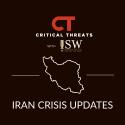Iran Crisis Update, October 6
Oct 6, 2022 - ISW Press
Iran may attack the US, Israeli, and/or Saudi targets in retaliation for the role Iranian officials claim those countries have played in stoking the ongoing, anti-regime protests. This assessment is based on rhetoric from Iranian military leaders on October 6. Senior Iranian military officers released a statement accusing the US, Israel, and Saudi Arabia of coopting and stoking the protests and vowed to retaliate. The content and nature of the statement suggests that the heads of each major military and security body approved its release. The statement did not list the names of these officers but noted that they are from the following military bodies:








